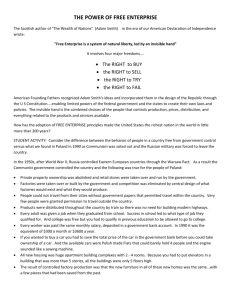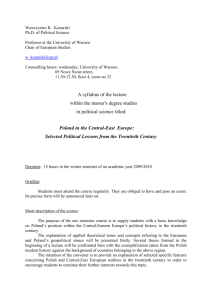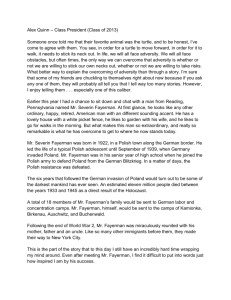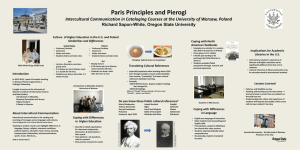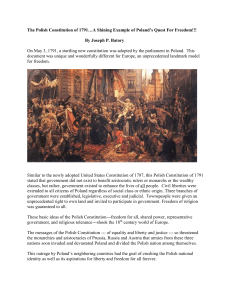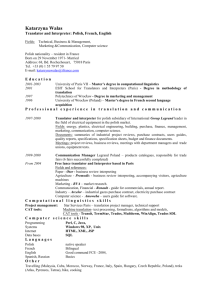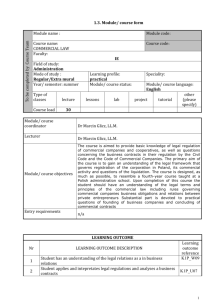THE HISTORY OF POLAND
advertisement
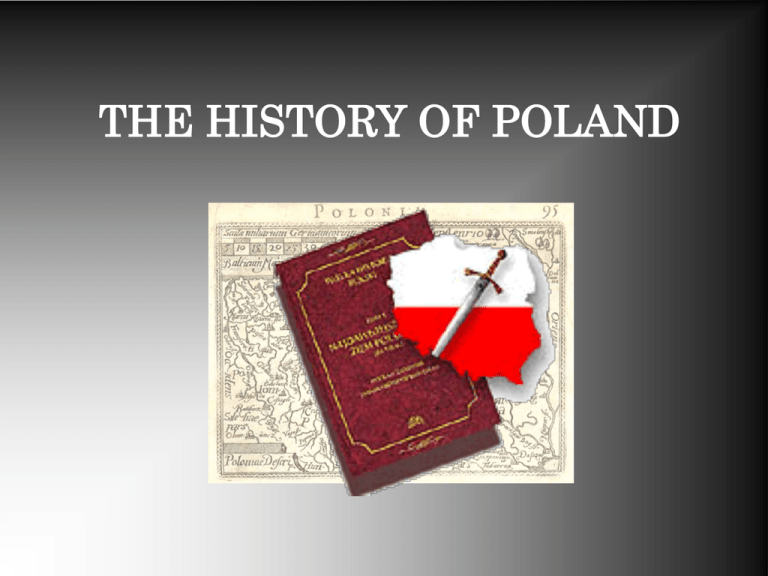
THE HISTORY OF POLAND Polish History is very important to all Poles. Our culture is based on our history. Therefore It is necessery to find out anything about most important historical events to understand Poland and Poles. WHEN THE GOD WAS A SUN Biskupin Biskupin - a settlement from the turn of the Bronze Age and the Early Iron Age (750 - 600 BC.) THE FORMER SLAVONIC GODS PIAST DYNASTY Mieszko I (ca. 935 - May 25, 992), son of the semi-legendary Siemomysł, was the first historically known Piast duke of the Polans, who gave their name to the country that would later be called "Poland." In 965 he married Dobrawa. Mieszko was baptised in 966, probably under the influence of his Christian first wife. In A.D. 1000, Holy Roman Emperor Otto III, while on pilgrimage to the tomb of St. Adalbert at Gniezno, invested Bolesław with the title Frater et Cooperator Imperii ("Brother and Partner in the Empire"). Some historians state that the Emperor also pledged a royal crown to Bolesław. During that same visit, Otto III accepted Gniezno's status as an archbishopric Kazimierz is the only Polish king who did receive and maintain the title of the great in Polish history. He built many new castles, reformed the Polish army and Polish civil law and criminal law. He founded the University of Kraków. The Jagiellon era is usually characterized as the beginning of Poland's "golden age" and saw the country become a major European power and extend her frontiers to the north and east. With the Union of Krewo in 1385, Jogaila married Queen Jadwiga of Poland (who was then only 11 years old) and established the Jagiellonian dynasty, which would rule in Poland and Lithuania until 1572. In military terms, his reign is noted for the crushing defeat inflicted on the Teutonic Knights in neighbouring Province of Prussia by Polish and Lithuanian forces under his supreme command at the Battle of Grunwald 1410. The Battle of Grunwald 1410 PRUSSIAN HOMAGE 1525 The situation along Poland's northern borders normalized in 1466 following another defeat of the Teutonic Order by king Casimir IV the Jagiellonian in the Thirteen Years War . In the outcome, the Eastern Pomerania with the city of Gdansk were returned to Poland. In 1525, Albrecht Hohenzollern, the last Grand Master of the Teutonic Order, converted to Lutheranism and established a secular duchy in East Prussia. He journeyed to Cracow to pay homage to the Polish King, Zygmunt I Stary (the Old), and to swear to the eternal association of his duchy with Poland. This moment, which many have seen as the zenith of Polish power, is immortalized in the famous painting by Jan Matejko. GOLDEN LIBERTY Zygmunt I Stary Bona Sforza Zygmunt II August Mikołaj Kopernik COPERNICUS' DE REVOLUTIONIBUS ORBIUM COELESTIUM - 1543 JASNA GORA The Deluge (Polish Potop) is a name commonly assigned in the history of Poland to a series of wars in the 17th century which left Poland in ruins. In a stricter sense Deluge refers only to the Swedish invasion and occupation of the country. In 1683, he led the Polish army of 30,000 men to relieve Vienna besieged by the Turks. The charge of the huzaria, Polish heavy cavalry, smashed the Turkish lines and ended once and for all the centuries old Turkish threat to Central Europe. HUSARIA The pride and glory of the cavalry, its mailed first, was the Husaria, the winged cavalry (or "winged horsemen"). These well trained and elite units served in the armies of the Polish and Lithuanian Commonwealth from around the early 16th century to the early 18th century. THE MAY 3rd CONSTITUTION - 1791 THE PARTITIONS 1772-1795 The three partitions occurred: February 17, 1772 January 21, 1793 October 1795. KOSCIUSZKO INSURRECTION - 1794 The Kosciuszko Uprising was Poland's final attempt to maintain independence. Tadeusz Kosciuszko, a Polish hero of the American Revolution. Thus, the Polish state, as an entity, disappeared off the map of Europe. It would take 123 years, until November 11, 1918, before Poland fully regained its independence. Though dreams of independence died, Poland's populace had been liberated from the bonds of serfdom. Poles outside the nobility were now considered part of the national fabric and the concept of Polish nationalism became an enduring 19th century concept; ensuring the nation's survival and eventual rebirth. Polish Legions in Italy is the name applied to the several different Polish units serving in the French army from the 1790s to 1810s. After the third partition of Poland in 1795 many Poles believed that the revolutionary France and its allies would come to aid of Poland, as France enemies included the partitioners of Poland Polish Legions in Italy Those units were commanded, among others, by Jan Henryk Dąbrowski, Karol Kniaziewicz and Józef Wybicki. Polish Legions serving alongside the French army during the Napoleonic Wars saw combat in most of Napoleon's campaigns, from West Indies, through Italy and Egypt, to Russia. MAZUREK DĄBROWSKIEGO Mazurek Dąbrowskiego (Dąbrowski's Mazurka) is the Polish national anthem, written by Józef Wybicki in 1797. Originally called the "Anthem of the Polish Legions in Italy", it is also informally known in English as "Poland Is Not Yet Lost" or "Poland Has Not Yet Perished" from its initial verse, "Jeszcze Polska nie zginęła," which is sometimes erroneously taken to be the Polish state motto. Fryderyk Franciszek Chopin is one of the most famous, influential and admired composers for the piano, and Poland's most significant composer. He was born, of French and Polish parentage in the village of Żelazowa Wola, Poland. Jan Matejko Jan Matejko he was born in Free City of Kraków, June 24, 1838 – November 1, 1893, Kraków, was a Polish artist famous for paintings of notable Polish political and military events. These include a Battle of Grunwald, numerous court scenes, and a gallery of Polish kings. He is also known for his portrayals of the famous Polish court jester Stańczyk. NAPOLEON I BONAPARTE By 1812, advisors to Alexander suggested the possibility of an invasion of the French Empire (and the recapture of Poland). Napoleon, in an attempt to gain increased support from Polish nationalists and patriots, termed the war the "Second Polish War" (the first Polish war being the liberation of Poland from Russia, Prussia and Austria). Polish patriots wanted the Russian part of partitioned Poland to be incorporated into the Grand Duchy of Warsaw NOVEMBER UPRISING - 1830 The November Uprising (1830– 1831)—also known as the Cadet Revolution—was an armed rebellion against Russia's rule in Poland. It was started on November 29, 1830 in Warsaw by a group of young conspirators from the army's officer school in Warsaw and was soon joined by large part of the Polish society. JANUARY UPRISING - 1863 The January Uprising was the longest Polish uprising against Tsarist Russia: it began January 22, 1863, and the last insurgents were not captured until 1865. It started as a spontaneous protest by young Poles against conscription into the Russian Army. WORLD WAR I 1914-1918 Ignacy Jan Paderewski (November 6, 1860 – June 29, 1941) was a Polish pianist, composer, diplomat and politician, the third Prime Minister of Poland. Józef Piłsudski-was a Polish revolutionary and statesman, field marshal, first chief of state (1918-1922) and dictator (1926-1935) of renascent Poland, and founder of her armed forces. He is generally regarded by much of modern Poland as a national hero. INDEPENDENT POLAND - 1918 - 1939 WORLD WAR II - 1939-1945 Under the leadership of Adolph Hitler, Nazi Germany invaded Poland on September 1, 1939. Hitler's excuse for the invasion was the need to secure "that intolerable Polish corridor." In response to the invasion of Poland, France and Britain declared war on Germany. World War II had begun. World War II, also, The Second World War, was the global military conflict that took place between 1939 and 1945. WWII was the largest and deadliest war in history. At last the Germans were on the defensive. With the Soviets advancing from the east and the allies from the west, Hitler's Third Reich collapsed into disarray and, following the Fuhrer's suicide, surrendered on May 8, 1945. WESTERPLATTE War broke out in Europe on 1 September 1939, with the German invasion of Poland. Schleswig-Holstein HOLOCAUST AUSCHWITZ concentration camp The Holocaust is the name applied to the systematic state-sponsored persecution and genocide of the Jews of Europe and North Africa along with other groups during World War II by Nazi Germany and collaborators. Auschwitz is the name loosely used to identify the largest Nazi extermination camp along with two main German concentration camps and 45-50 sub-camps. The name is derived from the German name for the nearby Polish town of Oświęcim Tragic Warsaw uprising of 1944 As the war progressed, a ferocious resistance to the Nazi occupation smoldered, then burst into flame, culminating in the tragic Warsaw uprising of 1944. The Polish underground State had one of the largest and best organized army in Nazi-occupied Europe. From city basements to guerilla camps hidden deep in primeval forests, members of the resistance struck back at the Germans whenever and wherever they could. SOLIDARITY - 1980 ROUND TABLE AGREEMENTS - 1989 The disillusioned Polish people demanded full political and cultural freedom. Polish workers understood how their economic relations with the Soviet Union had been rigged to the detriment of the Polish economy and in 1980 the Solidarity Movement exploded with a series of strikes on the Baltic Coast and in the industrial region of Upper Silesia. The situation was volatile but the new labor union was joined by a social movement, coalescing into an effective social force that managed to effect change with a minimum of violence. In August 1980, the Polish government recognized Solidarity and made significant concessions to the workers' demands. . Finally, as the spirit of "glasnost" engulfed the entire Soviet Bloc, the government recognized Solidarity again and, in the "Roundtable Agreements" of 1989, agreed to the sharing of power. POLAND IN NATO - 1999 On 12 of March 1999 - Prof. Bronislaw Geremek, Minister of Foreign Affairs of the Republic of Poland, transferred in the US Secretary of State, Madeleine Albright's hands the Instruments of Accession. From this very moment the Republic of Poland has been the legal party of the Washington Treaty - the member of NATO. Poland in European Union Polish voters then said yes to the EU in a referendum in June 2003. Poland joined the European Union on 1 May 2004. NOBEL PRIZE Maria Skłodowska-Curie Czesław Miłosz Henryk Sienkiewicz Lech Wałęsa Władysław Reymont Wisława Szymborska THE GREATEST POLE- JAN PAWEŁ II (JOHN PAUL II) Pope John Paul II, born Karol Józef Wojtyła [1] (May 18, 1920 – April 2, 2005) reigned as pope of the Roman Catholic Church for almost 27 years
